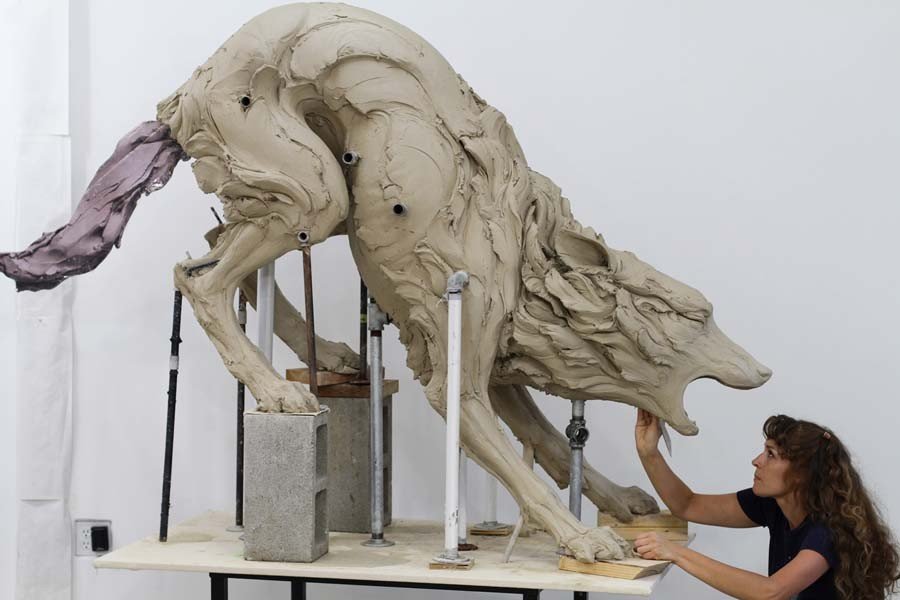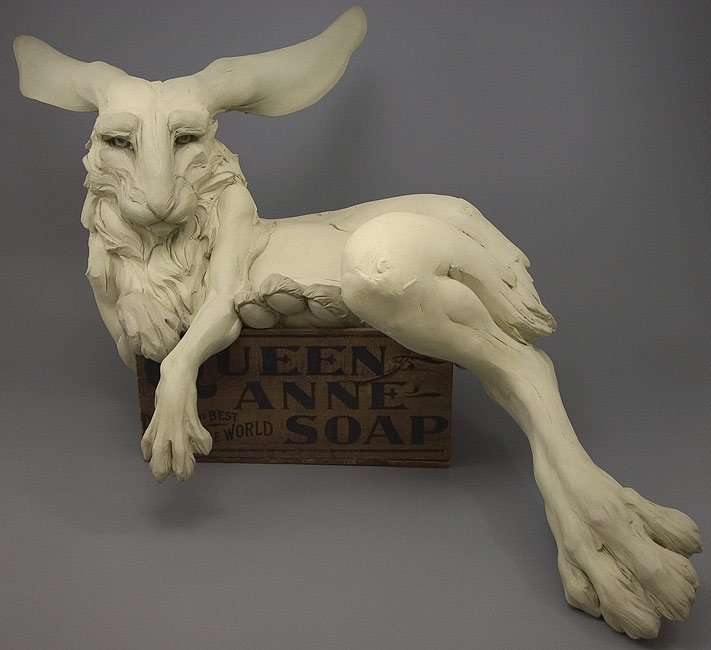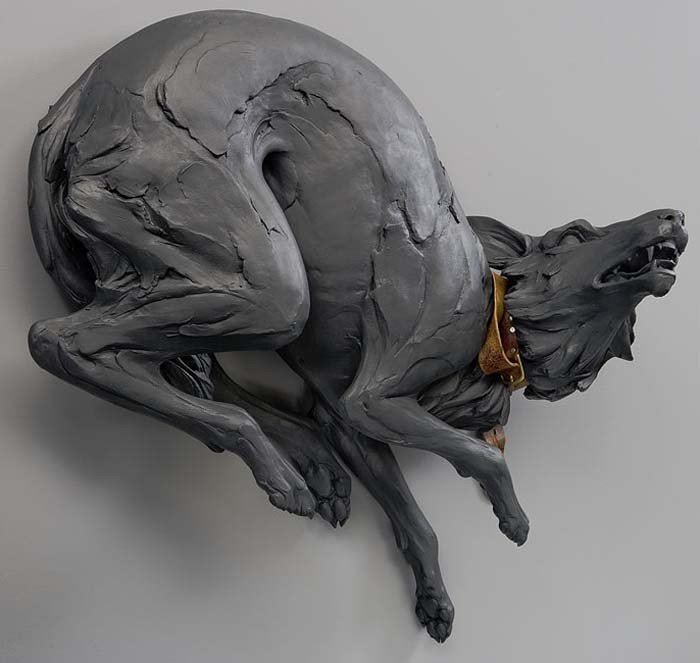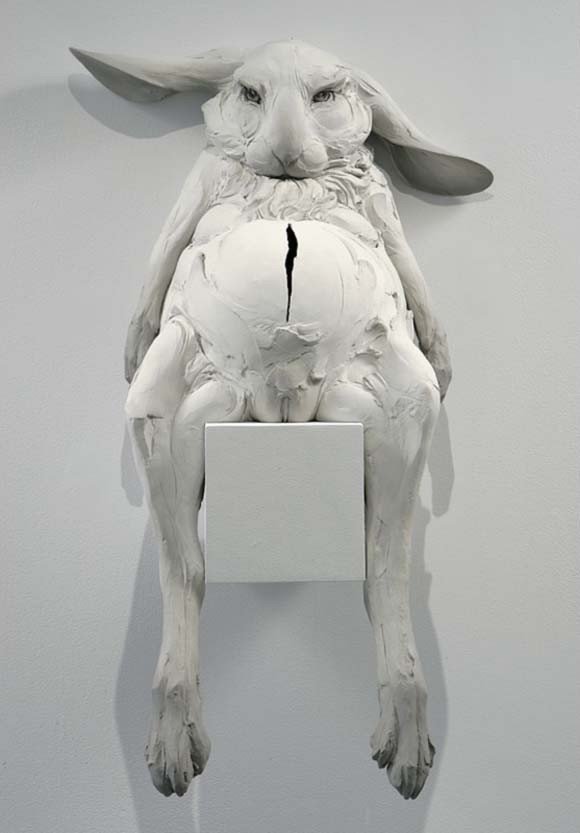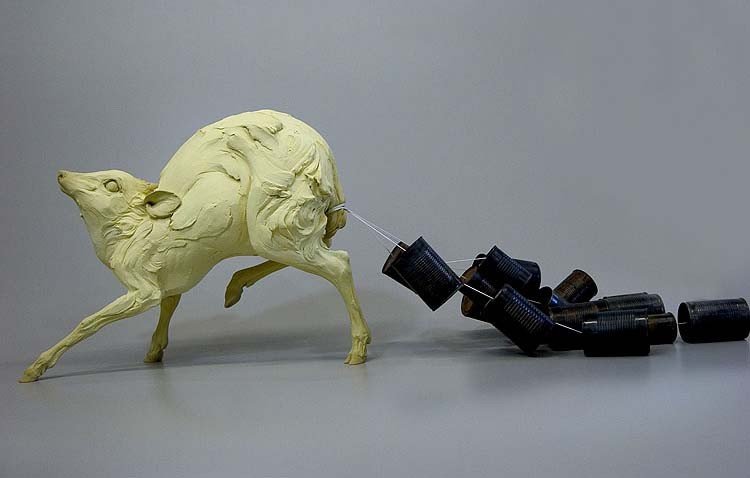The subtle, honest and dramatic nature of a creature caught in the moment is also caught in the remarkable sculptures of Beth Cavener Stichter. As humans, we always try to have a certain level of composure, hiding behind a mask of humility, shame and pride. Yet, Beth beautifully captures the primitive origins of the human psyche in an animal form. With her work, we are able to step into the raw depths of the human mind and experience it through the feral movements of an animal. After years of stepping into the blunt, untamed nature of the human mind and comparing it so wonderfully with that of Mother Nature’s creatures, she stopped by Gblog to enlighten us about her amazing work.
I love how the emotional expressions of your sculptures are so intense and dramatic. Do you feel any part of your own personality to be represented in your work?
Absolutely! My initial inspiration comes from taking a close look at the people around me, and imagining how their inner hidden conflicts and desires might appear if they were suddenly manifested in physical form. Sometimes the portraits I create are of people I have known closely for many years, while others are snapshots of someone with whom I have exchanged no more than a glance, a 5 minute conversation, or some other brief encounter. What they all have in common is that some aspect of their human character- whether it is alluring or repulsive- struck me, and I have sought to understand and articulate that moment through these animal skins. What’s just as important is that while these pieces take their inspiration from the people around me, they have all been filtered through my own perceptions. Since I am overtly conscious that this is how I see others, rather than any specialized secret knowledge of their inner motivations, these sculptures can also be seen as partial self-portraits. They are products of self-examination and a desire to understand the relationships and motivations of everyone around me.
When you’re hollowing out the sculpture, do you feel like you almost become the animals in order to create them? What goes through your mind?
Working solid with hundreds and sometimes thousands of pounds of clay on a metal armature is an intensely physical process. I often think of these first 3- 5 days of sculpting as a representation of the masculine and raw side of creating- often using my entire body and a chunk of rough wood to move the material around. After the initial stages of handling the material, I will spend the next 2 months carefully dissecting the solid clay from the armature, section by section, and hollowing each piece down to 1/4 inch thickness before reassembling the whole to be fired. Each of those gestural marks on the surface is carefully mirrored on the inside leaving the whole sculpture as a thin fragile skin shed of its interior mass. This second stage of the process has a strangely feminine association for me, as it requires a delicacy of touch and hundreds of hours refining the smallest details and pushing at the clay skin of the animal from the inside, swelling the muscles and folds to create a sense of vitality and tenderness.
By the time I successfully bring a piece to its final stages, I have spent approximately 1/8 of my time creating the form, and the remaining 7/8 of the time preserving it. It is a strange process. As I am hollowing the sculpture, piece by piece, that empty space inside becomes one of the most intense focal points for my thoughts about the conceptual image, as well as my relationship with them. I gain a secret satisfaction from all this weight loss. I follow each curve and mark in the reverse, thinking about their meaning, and rereading my visual notes. I like to hum into these dark closed interiors, listening to and feeling the deep vibrant magnification of my voice distorted in answer. I think about closing myself in, slipping them on like skins. I imagine being enfolded within a wild hare, ears laid back, body tensed… watching.
In one of my most recent works, “In Bocca al Lupo” the interior space took on a more significant role. Because I was drawing from experiences and memories of my own childhood, I designed this self portrait to feed from the idea of repression and a “holding in.” To this end, I wanted to choose a large scale that would not only evoke the sense of feeling small in its presence, but the scale was also specifically chosen so that the hollow piece was large enough for me to curl up inside its belly and throat.
On your website you say “that clay not only is the inert nature of the material alluring with its ties to the primitive and raw, but its voice spans a wide range of sensual, violent, and careless textural possibilities.” Do you think that there’s any other material in nature that can mimic the characteristics of clay?
I have worked in other materials briefly…mostly in graduate school, where I spent 10 weeks building with sticks and wire; 8 months working with robotic sculpture; a quarter welding with steel; another quarter using fall leaves and tree resin to construct a burrow 15 feet square, filling my studio to the top of the walls; and another very long stint working with molds: casting in paper, resin, rubber, wax, plaster, and bronze. All of these materials divorced me in some way from the fluidity of expression that I had grown dependent on in clay. Although they all centered around aspects of construction and therefore the tactile sense, they seemed very separate from the touch of my hands…more of an intellectual exercise.
I enjoyed all those processes immensely…and still do! I still use quite a bit of metal fabrication as support for my work, and occasionally there are some other elements like sugar, fabric, wood, found objects, and mechanical bits that find their way into my images. But mostly I am focused in the clay. It is my first language, and the one that is ultimately the most satisfying. Clay is so much like flesh. When I’m working with it, it’s as close as you can get to molding another person’s body. It responds to touch, it remembers your fingers… everything about it is so sensual. Creating a human form (which, again, is essentially what I’m doing) out of any other material feels like secondary translation. Although I love working, for example, with metals – the way that they change over time and react to the environment; other media will always be supplementary.
Do you feel that the language of the human body is more honest than that of the human mind?
This is a interesting question! Ultimately, I am most intent on exploring the shadowy depths of the human mind, but since I am trying to capture it, paused in a single complex moment, I use the language of the body to give those thoughts and emotions a voice. Both human and animal interactions show patterns of intricate, subliminal gestures that betray intent and motivation. The things we leave unsaid are far more important than the words spoken out-loud to one another. I have learned to read meaning in the subtler signs; a look, the way one holds one’s hands, the incline of the head, the rhythm of a walk, and the slightest unconscious gestures. I rely on animal body language in my work as a metaphor for these underlying patterns, transforming the animal subjects into human psychological portraits.
What is your favorite animal to sculpt? Why?
When I was in graduate school, I decided to make the shift into using animal forms. But I was worried about doing it because there are so many animals and cultural associations with particular species – how would I establish developed characters if I used a random animal every time? So I chose three distinct animals that would embody three different personality types: the victim, the bully, and the manipulator. At the time I chose the hare, the wild boar, and the goat to represent those three character types. They were way over-simplified, but it was fun to subvert that – how could I make a manipulative victim? Or a bully-manipulator? Since then, as the characters and my ideas have evolved, I have settled on 4 favorite archetypes, represented by the Hare, the Goat, the Wolf, and The Beast (an amalgamation of a prehistoric horse, tapir, hippo, and capybara!)
It all stems back to when I was a really young — we moved every two years of my life, all the way up until high school. I was always in different schools, which meant I would always be the outsider, the stranger. In response, I developed a defense mechanism in order to classify people into groups in order to figure out how I fit into that situation — more subconsciously than consciously. Since I was a child at the time, these categories were defined in terms of animals, because all the picture books I read categorized human behavior this way. You know, the pigs are this human character type, the wolves are this other type. I’m interested now in what that says about the person making the distinctions rather than the animal being personified.
Do you think humans and animals share more characteristics than we like to say?
I choose animals to represent human characteristics, so I find that there are similarities. However, I think most of those similarities are social constructs in a way. We want to anthropomorphize animals, we want to see them as being human-like. So I think we ascribe motivations or complexity to their behavior and actions that they probably don’t actually own. But I’m not ultimately interested in what animals are really like. What I’m interested in is what we think they are like, and how we see ourselves in them. I like the idea of borrowing the perceived moral innocence of the animal, something we desire to see in ourselves, in order to highlight just how strange and complex and unlike an animal those emotional and psychological states are.
The animal body is removed just enough from my own to establish a distance, yet the personal relationship is irresistible. Though I feel out of place and uncomfortable with hooves and pricked ears, I can still make them my own. Inside the animal body, I become far enough away from my self to unravel questions previously tangled in the self.
There is a beautiful simplicity among animals. I see so much of us reflected in their bodies and behavior, but somehow even those negative aspects are transformed into something I can accept. I admire the unselfconscious way they live their lives. There is violence and sex and death without pretense. Their physicality and vulnerability define their character.
I want to develop an allusion to those uncomfortable, awkward edges between the animal and human. Toward this end, I have become much more interested in working with group of figures that create an emotionally charged space. They are caught up in situations that are mysterious and ominous, posed and poignant, awaiting uncertain outcomes. Caught in various states of struggle and resignation, it is unclear how they arrived there and who or what is responsible, continuously asking the questions, “Who am I? And why am I here?” I aim for something subtly feral and uneasy- creating a space that serves as a psychological and emotional release, a reflection of ourselves through a distorted bestial lens.
Our level of development is defined also by the way we seek or desire. Even if we were alone in a remote part of the world we would still want food, sex, family, a home and much more. How does human desire come into play in your work and how can it be represented through figurative art? We do see it quite largely across your work. What is the idea that makes you want to explore this side of our existence?
I’m rarely trying to capture just one emotion in a particular a piece. What fascinates me is how our desires and motivations are often in direct and simultaneous opposition to one another, push and pulling. In many of the images I create, this conflict takes on a physical manifestation through an object intruding on the flesh of the clay body (like a rope or a piece of metal). In any given moment, we are rarely engaged in one pure emotional state. It’s usually a conflict between two or more desires, laced other emotions such as fear, regret, or guilt. The way I think about desire isn’t usually as simple as “I want food” or “I want sex.” It’s usually “I want food, but I’m self-conscious of my body image” and so I have this desire to be beautiful and a desire to eat something that tastes good and it gives me pleasure in the moment.” There’s usually a conflicting desire that creates a moment of anxiety and doubt and stress. Where conflicting desires come and tangle together is what draws me in.
The raw, disturbing emotions of the human psyche is greatly represented within your work. Do you think there’s any form of the seven deadly sins seen in any of your creations?
The images I create are visual questions, rather than statements of opinion, as I struggle to reevaluate my own assumptions about human behavior and motivation. This ongoing internal investigation allows me to delve into subjects I find deeply uncomfortable, using the sculptures I create as a means to speak of things I find impossible to put into words. What really drives the work is the attempt to lure others into confronting these same issues.
Initially, I created these figures as individual portraits capturing the absurd and the profound traits of people while critiquing their behavior with one another. As the work evolved, I became interested in how my own lens was distorting my view of human interaction, and I began designing the sculptures as partial or full self-portraits. This led me away from envisioning the pieces as individuals in order to begin creating figures that formed an installation addressing a specific psychological and social setting.
Transitioning from individual works towards groups of figures made choosing a specific theme to work around a more interesting conceptual tool. Most often, I will choose a central theme like regret, and try to understand how that theme is manifested in a wide variety of psychological states, both reacting to and within that emotional state. Usually the characteristics I am trying to capture in a group of figures are much more subtle, complex, and murky than a definitive vice, like the seven deadly sins. What makes human behavior so fascinating to me is the intertwining of good and bad motivations and impulses. The tangled subconscious mess that lies beneath the surface is what I hope to tap in to- the constant struggle between forces like fear, apathy, desire, fury, and hope. I often like to think of the images I create as a beautifully baited hook…an image constructed with desire and fear, that once taken in, sinks deep, and pulls you irresistibly towards somewhere unknown.
While the world is increasingly becoming more digital, people are still attached to traditional art such as sculpturing. What do you think about using social media as a venue to showcase a young artists work?
I’ve been using the internet to share my work since 1998, with a presence on the web with some form or other. My work has evolved in part by being able to share responses from people who wouldn’t normally be able to see the work in person. I want my work to be experienced by a larger audience than just those visit galleries and museums, which means that I have relied more heavily on the internet and digital media to be able to get my work out to all those people who would like to experience and support the work. I think it’s incredibly positive as a venue for young artists.
That being said, I think that there’s going to be a constant sort of struggle for that to be something that works well for sculpture and installation. I’ve always felt that my work comes across in a very limited way in photography. It’s really important that people can walk up to these pieces and experience the eye contact, the physicality of scale, and the placement of it in its environment. All of those physical experiences are conceptually important to me, and most of it is lost in a digital image. I think the digital medium is great for promoting the work, and sparking curiosity and interest in the work, but nothing can replace the experience of people seeing it in person.



